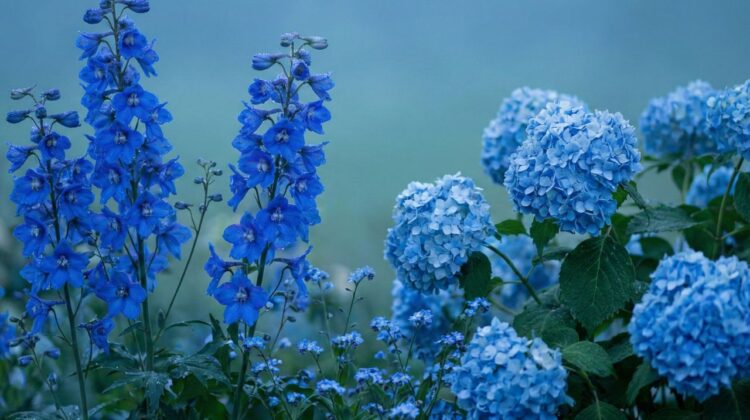
If you look at a color wheel of nature, you will notice something strange: Green is everywhere, but Blue is elusive.
True blue is the rarest color in the floral world. Bees love it (it’s the color they see best), but for gardeners, finding a flower that doesn’t drift into purple or violet is a lifelong quest. That rarity is exactly what makes a blue garden so magical.
As Shiny Aura, I find that blue flowers bring an instant sense of calm, depth, and cooling energy to a landscape. They recede visually, making small gardens feel larger and more expansive. Whether you want the pale sky blue of a spring morning or the deep indigo of the ocean, here are 12 stunning blue flowers to bring serenity to your home.
In this article, we'll cover
1. Delphinium (Larkspur)
If you want “True Blue,” this is the king. Delphiniums produce towering spikes (some up to 6 feet tall) covered in intense, electric blue flowers. They symbolize big-heartedness and fun.
Gardening Tip: They are heavy feeders and need staking to protect them from the wind. Varieties like the ‘Pacific Giant’ series offer the deepest, most satisfying blues you will ever see.
2. Cornflower (Bachelor’s Button)
This wildflower possesses a blue so unique it has its own name: “Cornflower Blue.” Originally a weed in grain fields, it is now a beloved cottage garden staple. It symbolizes delicacy and single blessedness.
Shiny’s Tip: It is an edible flower! Use the bright blue petals to garnish salads or freeze them in ice cubes for fancy summer drinks. They grow easily from seed in poor soil.
3. Hydrangea (Bigleaf)
The Blue Hydrangea is the chameleon of the garden. Its color depends entirely on the soil pH. In acidic soil (pH below 6), it blooms a brilliant sky blue. In alkaline soil, it turns pink.
Meaning: It represents apology and gratitude. To keep them blue, add coffee grounds or aluminum sulfate to the soil around the roots.
4. Himalayan Blue Poppy
This is the “Holy Grail” for plant collectors. The Himalayan Blue Poppy (Meconopsis betonicifolia) features silky, crepe-paper petals in a mesmerizing, icy turquoise-blue. It symbolizes dreams and luxury.
Gardening Note: It is notoriously difficult to grow. It needs cool, moist summers (like in the Pacific Northwest or Scotland). If you can get it to bloom, you are a master gardener.
5. Forget-Me-Not (Myosotis)
Tiny, humble, and unforgettable. Forget-Me-Nots produce clouds of tiny baby-blue flowers with yellow centers. They symbolize true love and memories. Legend says a knight threw these flowers to his love before falling into a river, shouting “Forget me not!”
Design Idea: Use them as a ground cover under spring bulbs like Tulips. The blue carpet makes the taller flowers pop.
6. Grape Hyacinth (Muscari)
These spring bulbs look like upside-down clusters of grapes. They offer a deep, rich cobalt blue that is rare in the early season. They symbolize power and confidence.
Why it works: They are tough and spread rapidly. Plant a “river” of Muscari along a walkway for a dramatic visual impact in April.
7. Morning Glory ‘Heavenly Blue’
Most Morning Glories are purple, but the ‘Heavenly Blue’ variety lives up to its name. It features large, saucer-shaped blooms in a clear, azure sky blue with a white throat. They symbolize unrequited love.
Shiny’s Tip: This vine grows fast and loves the sun. Plant it on a trellis or fence to create a wall of blue that opens every morning to greet you.
8. Iris
The Iris is named after the Goddess of the Rainbow, but it is most famous for its blue-violet shades. The Bearded Iris offers intricate, ruffled petals that add architectural structure to a border. They symbolize wisdom and hope.
Gardening Tip: Irises are incredibly hardy perennials. They thrive in full sun and their sword-like foliage looks good even when not in bloom.
9. Perennial Flax (Linum perenne)
If you want a flower that moves with the wind, choose Blue Flax. The satin-like, pale blue flowers open in the morning and drop their petals by the afternoon, only to be replaced by new ones the next day. It symbolizes domestic symbols.
The Aura: It creates a breezy, wildflower meadow effect. It is extremely drought-tolerant and perfect for xeriscaping.
10. Love-in-a-Mist (Nigella)
This flower is as romantic as its name. Nigella features delicate blue star-shaped flowers nestled in a mist of fern-like foliage. It symbolizes perplexity.
Bonus: After the flower fades, it forms a stunning balloon-like seed pod with maroon stripes, which looks amazing in dried flower arrangements.
11. Gentian
For an intense, dark blue, look to the mountains. Gentians are alpine plants that produce trumpet-shaped flowers in a color often called “Gentian Blue”—a shade so deep it looks almost velvet.
Meaning: It symbolizes intrinsic worth. It prefers cooler rock gardens with excellent drainage.
12. Sea Holly (Eryngium)
For something edgy and modern, try Sea Holly. It has spiky, metallic-blue bracts that look like thistles made of steel. It symbolizes independence.
Why it works: The metallic sheen reflects sunlight, making the plant literally sparkle. It lasts forever in a vase and adds texture to any bouquet.
Designing with Blue
Blue is a “cool” color, meaning it visually recedes. If you plant blue flowers at the back of a small garden, it tricks the eye into thinking the fence is further away.
- The Crisp Mix: Pair Blue with White for a nautical, fresh look.
- The Complementary Pop: Pair Blue with Orange (its opposite on the color wheel) for an energetic, high-contrast vibration.